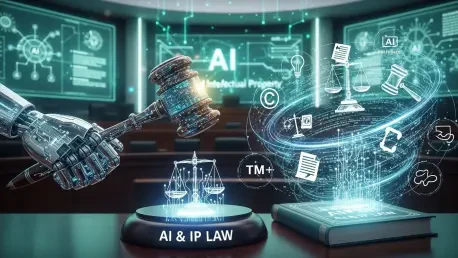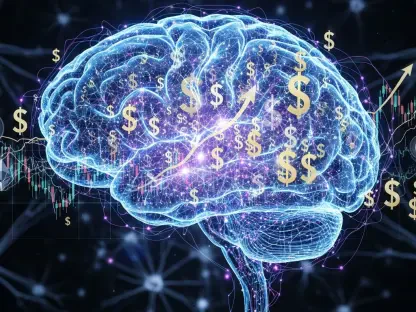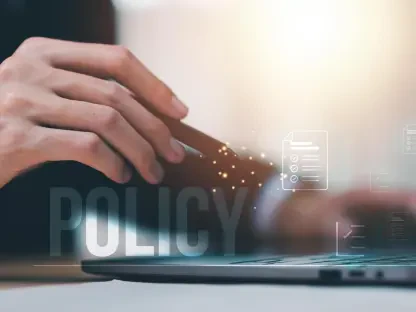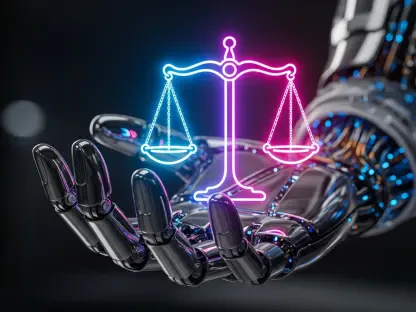Imagine a world where a machine composes a symphony, designs a groundbreaking invention, or generates a viral piece of digital art—all without human intervention beyond a simple prompt. This is no longer science fiction; artificial intelligence (AI) is already reshaping creative and innovative landscapes, challenging the boundaries of intellectual property (IP) law with profound questions about ownership, originality, and legal accountability. This review delves into the intricate relationship between AI and IP law, exploring how current frameworks are grappling with these advancements and what this means for industries and innovators today.
The Intersection of AI and IP Law
At the heart of this technological revolution lies a critical tension: how can IP law, designed for human creators and inventors, adapt to outputs and innovations driven by algorithms? AI systems, capable of generating content from music to software code, challenge traditional notions of authorship and inventorship. In the UK, where legal structures have long prioritized human agency, the rise of AI-generated works is creating unprecedented dilemmas for policymakers, businesses, and courts. This review examines the core features of AI in relation to IP, focusing on its capabilities and the legal conundrums it introduces.
The significance of this intersection cannot be overstated. As AI tools become integral to industries ranging from entertainment to engineering, the need for clarity in IP rights grows urgent. Without updated legal guidance, companies risk costly disputes, while creators fear losing protections for their contributions. This analysis aims to unpack these challenges, providing a detailed look at how AI’s functionalities test the limits of copyright, patents, and data rights in real-world applications.
Detailed Analysis of AI’s Impact on IP Frameworks
Ownership Challenges in AI-Generated Works
One of the most pressing issues in AI and IP law centers on determining ownership of content produced by machines. When an AI system creates a painting or writes a novel based on user prompts, who holds the copyright—the individual who initiated the process, the developer of the AI tool, or perhaps no one at all under current definitions of originality? Existing copyright laws in the UK emphasize human authorship, leaving a significant gap when it comes to machine-generated outputs. This uncertainty stifles both innovation and protection, as stakeholders hesitate to invest in or rely on AI creations without clear legal standing.
Beyond the theoretical, this issue has practical ramifications for creative industries. Businesses leveraging AI for content production face potential disputes over licensing and royalties, especially when outputs mimic or derive from existing works. Courts have yet to establish consistent precedents, meaning each case could set wildly different standards. This lack of uniformity complicates strategic planning for companies and artists alike, highlighting a critical flaw in the current IP system’s adaptability to AI technologies.
Patent Eligibility for AI Innovations
Another complex area lies in patent law, where AI systems themselves are often the subject of innovation. Take, for instance, the case involving Emotional Perception AI, heard in the UK Supreme Court in the current year. This dispute questions whether artificial neural networks (ANNs), a cornerstone of modern AI, can qualify for patent protection as inventions. The outcome of such cases could redefine how IP law recognizes machine-driven advancements, potentially opening or closing doors for tech companies seeking to safeguard their developments.
The debate extends beyond individual cases to broader policy implications. If AI systems are deemed ineligible for patents, it could discourage investment in cutting-edge research, as firms might struggle to secure exclusive rights to their innovations. Conversely, granting patents too broadly risks monopolizing foundational technologies, limiting access for smaller players. This delicate balance between encouraging progress and preventing overreach remains a pivotal concern for legal and industry experts navigating AI’s role in invention.
Training Data and the Risk of Infringement
AI’s reliance on vast datasets for training introduces another layer of IP complexity, particularly around infringement risks. The high-profile case of Getty Images v Stability AI, adjudicated in the English High Court earlier this year, underscores these challenges. It raised allegations of copyright and trademark violations tied to the use of protected images for training AI models, as well as the unauthorized reproduction of watermarks in outputs. Though parts of the claim were withdrawn, the case signals growing scrutiny of how AI systems access and utilize existing IP.
Jurisdictional hurdles further complicate matters. With AI models often trained in one country but deployed globally, determining which laws apply becomes a logistical nightmare. Database rights, meant to protect structured collections of information, also come into play, yet their application to AI training sets remains ambiguous. For businesses, this creates a minefield of potential legal exposure, necessitating robust strategies to ensure compliance while pushing technological boundaries.
Recent Legal and Policy Developments
The legal landscape surrounding AI and IP is evolving rapidly, driven by landmark cases and governmental action. Beyond courtroom battles, the UK government concluded a public consultation on AI and copyright earlier this year, drawing over 11,500 responses from diverse stakeholders. This initiative reflects a broad recognition of the issue’s complexity and the urgent need for updated guidelines that address both creative rights and technological growth.
In response to this consultation, an expert working group was established in mid-2025 to tackle unresolved gaps in IP frameworks. This collaborative effort aims to propose solutions that reconcile the interests of AI developers with those of traditional rights holders. Such developments suggest a proactive shift toward addressing AI’s unique challenges, though the diversity of opinions indicates that consensus will require sustained dialogue and compromise.
These policy moves are complemented by judicial rulings that are beginning to shape the field. As courts interpret existing laws in light of AI-specific scenarios, their decisions are laying the groundwork for future standards. For industries reliant on AI, staying abreast of these changes is essential, as they could redefine competitive landscapes and operational risks in the near term.
Practical Applications and Business Implications
AI’s integration into IP contexts offers both transformative opportunities and significant pitfalls for businesses. In creative sectors, AI tools are already generating content at scale, from advertising copy to visual designs, enabling unprecedented efficiency. However, without clear ownership rules, companies face uncertainty over how to monetize or protect these outputs, often leading to hesitancy in fully adopting such technologies.
In technology and engineering, AI-driven innovations are accelerating product development, yet the ambiguity around patent eligibility poses a barrier to securing investments. Simultaneously, AI is being harnessed for IP enforcement, with algorithms detecting infringements or counterfeit goods online. This dual role as both creator and enforcer underscores the technology’s versatility but also amplifies the stakes of legal missteps for firms navigating this space.
For startups and established enterprises alike, the key lies in proactive risk management. Clear contractual agreements regarding data use and output ownership are becoming indispensable, as is legal counsel to anticipate potential disputes. As AI continues to permeate various sectors, its intersection with IP law demands vigilance, ensuring that innovation does not come at the expense of compliance or ethical considerations.
Conclusion
Reflecting on this exploration of AI and intellectual property law, it becomes evident that the technology’s rapid advancement has outpaced the legal frameworks meant to govern it. The challenges of ownership, patent eligibility, and training data infringement stand out as critical areas where clarity is lacking, while recent legal cases and policy initiatives offer glimmers of progress. For stakeholders, the journey ahead hinges on actionable strategies—collaborating with legal experts to draft precise contracts, monitoring judicial outcomes for emerging precedents, and engaging in policy discussions to shape balanced regulations. Looking forward, the focus should shift to fostering international cooperation, as AI’s global nature demands harmonized standards to prevent jurisdictional conflicts. Only through such concerted efforts can the promise of AI be realized without undermining the foundational principles of intellectual property protection.









